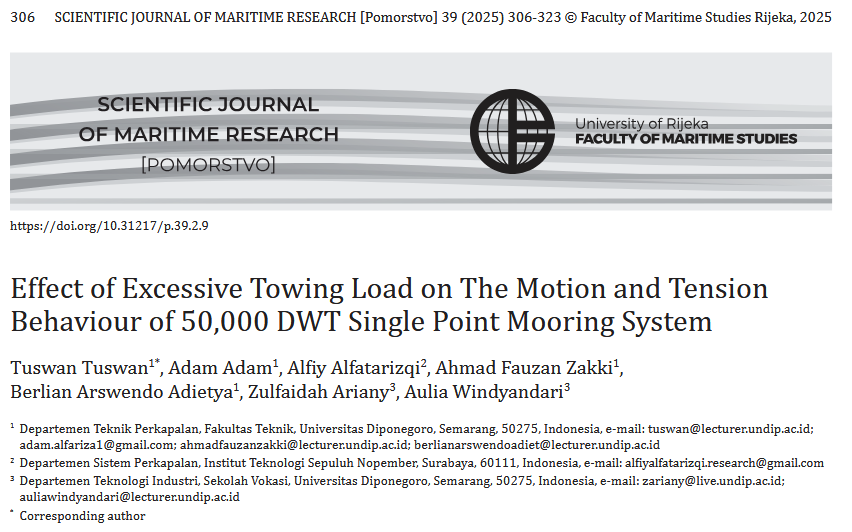Effect of Excessive Towing Load on The Motion and Tension Behaviour of 50,000 DWT Single Point Mooring System
Keywords:
Mooring analysis, Tension analysis, Single point mooring, TankerAbstract
Catenary Anchor Leg Mooring (CALM) systems are vital for offshore oil and gas operations to moor Tankers and transfer cargo. A common issue arises when Tankers exceed the mooring system’s design capacity, leading to shifts in the Single Point Mooring (SPM) coordinate. This study examines the structural integrity of a 50,000 DWT CALM-type SPM system under excessive mooring loads, simulating conditions with Tankers of 55,000, 75,000, and 100,000 DWT. The analysis follows API
RP 2SK, DNV OS E301, ABS standards and includes three stages: (1) Hydrodynamic analysis to obtain the Response Amplitude Operator (RAO); (2) 3D coupled dynamic time-domain simulation to determine mooring line tension; and (3) Von Mises stress analysis of the Y-connection. Results show that increasing tow loads elevate mooring line tension, with the highest force found in Chain 1C under beam sea with a 100,000 DWT Tanker. The maximum stress occurs at the Y-connection in hole
C facing the seabed, failing to meet safety requirements. These findings highlight the critical need for adherence to design load limits to ensure safe and reliable mooring system performance.

Downloads
Published
Issue
Section
Categories
License
Copyright (c) 2025 Tuswan Tuswan, Adam Adam, Alfiy Alfatarizqi, Ahmad Fauzan Zakki, Berlian Arswendo Adietya, Zulfaidah Ariany, Aulia Windyandari

This work is licensed under a Creative Commons Attribution-NonCommercial-NoDerivatives 4.0 International License.
Scientific Journal of Maritime Research understands the need for authors to disseminate and maximize the impact of their research. When submitting an article for publishing in Scientific Journal of Maritime Research, it implies that the Corresponding Author transfers, with the consent of all Coauthors, the copyright ownership in the referenced submission, including all versions in any format now known or hereafter developed, to the Scientific Journal of Maritime Research.
Copyright protects your original work and research material and prevents others from using it without your permission. Others will be required to credit you and your work properly, thus increasing its impact. Should your submission be rejected or withdrawn prior to acceptance for publication by Scientific Journal of Maritime Research, this transfer will be null and void.
Authors, users or readers of an article need clear instructions on how they can use the article. Scientific Journal of Maritime Research uses the Creative Commons Attribution-NonCommercial-NoDerivatives (CC-BY-NC-ND) 4.0 International License, which governs the use, publishing and distribution of articles by authors, publishers and the wider general public.
The authors are allowed to post a digital file of the published article, or the link to the published article (Scientific Journal of Maritime Research web page) may be made publicly available on websites or repositories, such as the Author’s personal website, preprint servers, university networks or primary employer’s institutional websites, third party institutional or subject-based repositories, and conference websites that feature presentations by the Author(s) based on the published article, under the condition that the article is posted in its unaltered Scientific Journal of Maritime Research form, exclusively for non-commercial purposes.




